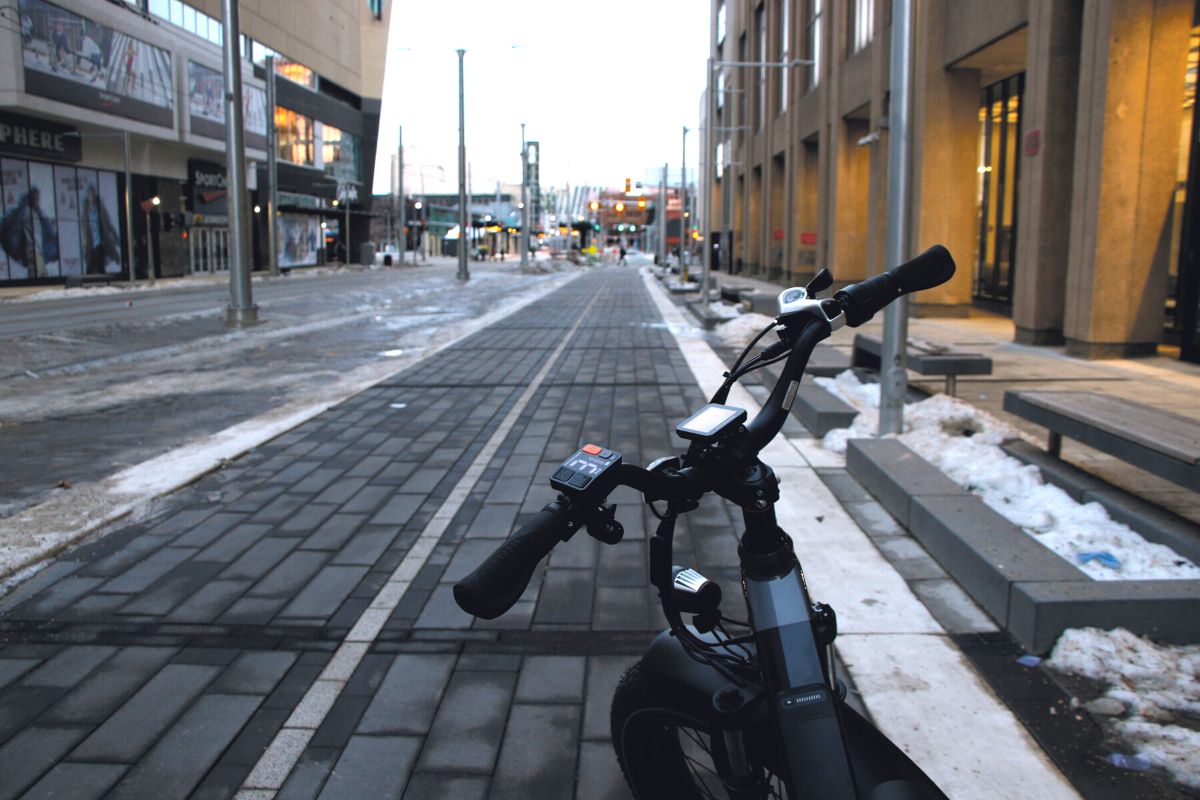I ride my bike nearly everyday, and when winter inevitably hits hard and fast I’m still out there. Naturally, having clear bike paths is important. The build-up of packed ice and snow can create some dangerous scenarios for all cyclists looking to commute or get some exercise during the frigid winter months. Cyclists should be prepared to bike more defensively to combat the ice, but this defence shouldn’t require six months of boot camp and basic training to fight off the relentless waves of ice.
I was running late for a film premiere at the Metro Cinema a few weeks ago, just a few days after our first major snowfall. Admittedly, I wasn’t being the most defensive or cautious cyclist as I cruised along the 109th street bike path just a block north of the High Level bridge. Having just passed 99th avenue heading southbound, I watched the ground ahead of me carefully, making sure to steer clear of all the slippery patches. All seemed to be going well until I had to make an icy descent. My front tire slipped out from under me, and my face met the cement, leaving a nice red trail behind (courtesy of my now-bleeding nose and hand). My bike slammed on top of me, and thankfully, it only sustained minor damage. I picked myself up and tried to find anything in my bag that would stop the bleeding, before eventually landing on a London Drugs receipt and some densely packed snow to shove in my nose. I got back on my bike ,fixed the headlight and began (very cautiously this time) to ride off once again.
I learned two things that night. First, I need to get some thick-studded tires. Second, the city’s snow clearing plan seems to exclude ice. The city of Edmonton’s prioritized bike route network says they will “maintain [snow levels] to a bare pavement standard within 24 hours following the end of snowfall.” Yet as my wounds told me, ice is not cleared to a pavement level. Somehow, the sneaky slippery level exists in a plane between pavement and snow and defies the city’s “Snow Clearing Priority Hierarchy.”
So could this be a problem with the way the city council handles snow clearing on our bike lanes? Well, across the 7.8 kilometres of dedicated downtown bike lanes, snow removal equipment changes to adequately fit the size of the lane. If a bike lane is at least three metres wide you can expect to see a street sweeper, a truck with a front mount blade or a broom to plough down to the bare pavement. Wherever the bike lanes are reduced to less than three metres, smaller equipment, such as skid steer loaders or tractors, will be used. Trucks armed with a liquid tank may also be seen applying anti-icing material to the paths.
But, the city could certainly act sooner during snowfall to clear out snow. The equipment used to clear the bike lanes can’t always sufficiently clear away ice buildup. It especially struggles on days when we see off-and-on freezing rain throughout the city.
These measures may not always keep bike lanes completely clear, but they are certainly a step up from the city’s previous use of heaping piles of calcium chloride spread generously over the pavement.
“All that salt that used to be on the roads destroys your bike. Ever since they [the city] stopped putting it down the bike lanes have been terrific,” said Ray, a 59-year-old cycling resident of Boyle Street.
Now that the snow is cleared and the salt is gone, the real danger presented to cyclists using bike lanes in the winter is the negligence of car drivers. Cars will routinely ignore bike lanes by not giving cyclists the right of way or completely ignoring the existence of the bike lanes altogether and driving straight down them (yes we see you, drivers in front of the Strathcona farmer’s market). Drivers routinely driving over bike lanes in the snow creates tread marks that melt and refreeze over and over again, turning the bike paths into impossible to navigate craters. This forces more and more cyclists into the road, making them an easy target for the heavy cars that command the lane.
To keep cyclists safe in the winter we can look to the city of Oulu, Finland for inspiration. One of the common problems along the bike path network are the white lane lines that are painted onto the ground. In the snow, they’re nearly impossible to spot. Oulu, nicknamed “the bike capital of Finland,” combats this problem by projecting lights from street lamps onto the lanes to indicate where it is safe for bikers and pedestrians to be. Increasing the network of safe biking lanes has had much more of an impact on the population of cyclists in Oulu than the cold weather ever has. This is just a small step, but could provide Edmontonians with visible improvements and keep everyone safe.
So, next time you set out to use the many bike lanes and multi-use paths the city has to offer, make sure to keep an eye out for dismissive drivers and sneaky ice routes. It’s always smart to wear a helmet, dress in layers and kit out your bike with all kinds of lights and reflectors. The City of Edmonton’s winter cycling guide has all the info you need to stay prepared for anything our freezing conditions throw your way.






